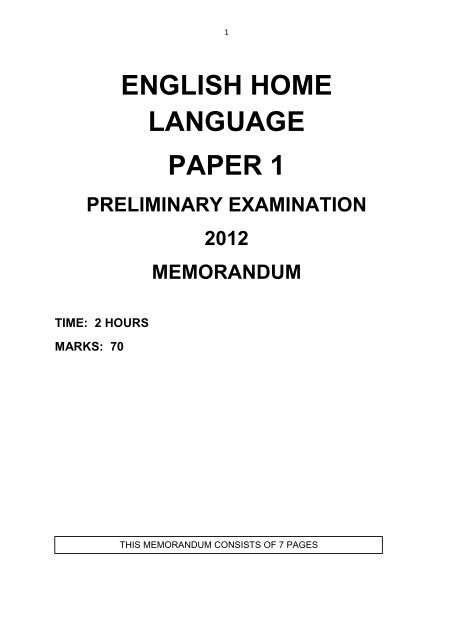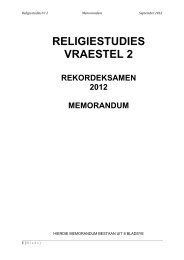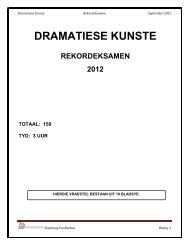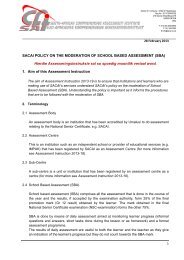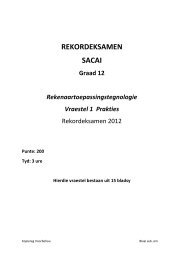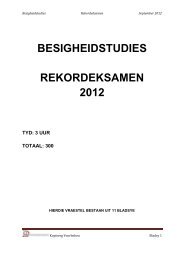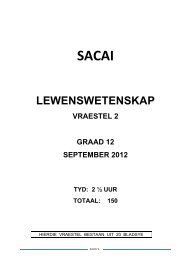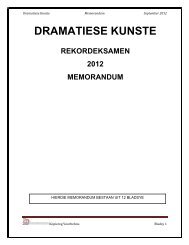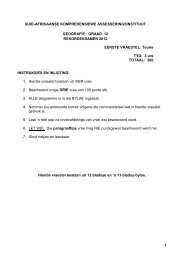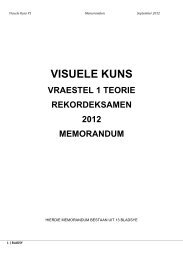English HL Paper 1 prelim 2012Memo FINAL.pdf - sacai
English HL Paper 1 prelim 2012Memo FINAL.pdf - sacai
English HL Paper 1 prelim 2012Memo FINAL.pdf - sacai
You also want an ePaper? Increase the reach of your titles
YUMPU automatically turns print PDFs into web optimized ePapers that Google loves.
1<br />
ENGLISH HOME<br />
LANGUAGE<br />
PAPER 1<br />
PRELIMINARY EXAMINATION<br />
TIME: 2 HOURS<br />
MARKS: 70<br />
2012<br />
MEMORANDUM<br />
THIS MEMORANDUM CONSISTS OF 7 PAGES
SECTION A: COMPREHENSION<br />
QUESTION 1: READING FOR MEANING AND UNDERSTANDING<br />
INSTRUCTIONS FOR MARKING THE COMPREHENSION<br />
2<br />
Incorrect spelling in one-word answers should be marked wrong.<br />
Incorrect spelling and language errors in longer responses should not be<br />
penalised as the focus is on understanding.<br />
For open-ended questions no marks should be awarded for YES/No or I<br />
AGREE/I DISAGREE. The reason/substantiation/ motivation is what should<br />
be considered.<br />
For TRUE/FALSE or FACT/OPINION questions, the mark should be split.<br />
Award 1 mark for TRUE/FALSE or FACT/OPINION and a mark for the<br />
reason/substantiation/motivation/quotation. No marks are awarded if no<br />
reason or substantiation is given.<br />
For questions which require quotations from the text, do not penalise<br />
candidates for omitting the quotation marks.<br />
When one-word answers are required and the candidate gives a whole<br />
sentence, mark correct provided that the correct word is<br />
underlined/highlighted.<br />
When two/three facts/points are required and a range is given, mark only the<br />
first two/three.<br />
If the candidate uses words from another language other than the one being<br />
examined, disregard those words. If the answer still makes sense, do not<br />
penalise.<br />
Accept dialectical variations.<br />
For multiple-choice questions, accept BOTH the letter corresponding with the<br />
correct answer AND the answer written out in full.<br />
QUESTIONS: TEXT A<br />
1.1 Cage-diving with sharks is irresponsible and hinders the sharks’ cause. /<br />
Cage-diving with sharks can be the experience of a lifetime and is helping the<br />
sharks’ cause. / (2)<br />
1.2 The article is written for scuba divers, / as it states that Ferreira has dived<br />
more than most other divers. The article is taken from the magazine DIVER, /<br />
thus it supports the fact that the people referred to are divers. (2)<br />
1.3 It is the act of luring sharks closer to the cage by using fish bait or fish parts.<br />
(The act of “befriending” – chum – the animals by luring them with<br />
bait.)(Please note: the candidate must state that it is the ACT of luring sharks.<br />
Simply saying that it is fish parts or bait is wrong.) (1)
3<br />
1.4 This omission of the general public’s opinion should be regarded in relation to<br />
the central message of the passage. / Ferreira implies that people often make<br />
invalid assumptions, but he wants to present facts. / Only those who are<br />
actually involved in cage-diving with sharks, that is, the scuba divers, are<br />
justified to air their opinions. / By only referring to the opinion of scuba divers<br />
and omitting that of the general public, he strengthens his argument that when<br />
one considers the facts, he would be proved correct. / (4)<br />
1.5 By referring to the bias as “shark-attack hysteria” / he is using emotive<br />
language which ridicules the bias. / Since the reader does not want to be<br />
categorized with those that are ridiculed, / the reader is manipulated to agree<br />
more readily with Ferreira. / (4)<br />
1.6.1 C sarcasm (1)<br />
1.6.2 He points out the discrepancies of public opinion: / many more sharks are<br />
attracted during salmon fishing than during cage diving, / but the public is<br />
unaware of their presence. (3)<br />
QUESTIONS: TEXT B<br />
1.7 False. / There are some key behaviours that can be observed to indicate<br />
whether a shark is comfortable with or antagonistic to the diver’s presence. /<br />
(1mark for FALSE and 1 mark for the substantiation.) (2)<br />
1.8 A human may fidget with his/her fingers when he/she is embarrassed.<br />
This question is open ended. Give credit for any reasonable answer. (1)<br />
1.9 Sharks A and D. / Both have arched (hunched) their backs, / their pectoral fins<br />
are lowered / and they exhibit more exaggerated movement. / (4)<br />
QUESTIONS: TEXTS A and B<br />
1.10 Both passages imply that sharks are not as vicious as they have been<br />
portrayed. / With proper knowledge and precautions divers can still be<br />
reasonably safe when they encounter sharks in the ocean. / (2)<br />
1.11 The register of Text B is somewhat less formal than that of Text A, / though<br />
both texts are factual in nature. / In Text A the writer takes a defensive stance<br />
by listing his arguments, / whereas Text B is more conversational as the<br />
reader is addressed more informally by the repeated use of the personal<br />
pronoun “you” (you should). /<br />
Mark globally and give credit for well-motivated responses. (4)<br />
TOTAL SECTION A: 30
SECTION B: SUMMARY<br />
QUESTION 2: SUMMARISING IN YOUR OWN WORDS<br />
INSTRUCTIONS<br />
Marking the summary:<br />
4<br />
Candidates should present the summary in the required format.<br />
Summaries not presented in the required format but reflecting another format<br />
of summarizing as prescribed in the Subject Statement for Languages should<br />
be assessed.<br />
Candidates must indicate the word count correctly.<br />
Award marks as follows:<br />
- 7 marks for 7 points<br />
- 3 marks for language<br />
Penalties:<br />
If the candidate has not presented the summary in the required<br />
format, the candidate should be penalised by deducting 1 mark<br />
from the total mark awarded.<br />
For direct quotations of whole sentences, penalise as follows<br />
from the total mark awarded for the points:<br />
o 1-3 whole sentences quoted: no penalty<br />
o 4-5 whole sentences quoted: deduct 1 mark<br />
o 6-7 whole sentences quoted: deduct 2 marks<br />
Language errors(grammar, spelling, punctuation): deduct from<br />
the 3 marks for language as follows:<br />
0-4 errors – no penalties<br />
5-10 errors – subtract 1 mark<br />
11 – 15 errors – subtract 2 marks<br />
16 errors or more – subtract 3 marks<br />
To avoid the anomaly that a student is able to score more marks for language<br />
than for the summary which is the core of the assessment, please take note<br />
that language mark distribution shall be as follows:<br />
To be awarded 1 language mark, at least 1-3 points should be<br />
correct.<br />
To be awarded 2 language marks, at least 4-5 points should be<br />
correct.<br />
To be awarded 3 language marks, at least 6-7 points should be<br />
correct.
5<br />
Subtract 1 mark from the total marks awarded for the points<br />
and language for not indicating the word count or if the<br />
summary is too long.<br />
NOTE: Abbreviations should not be used but should they appear in the<br />
summary, they must be counted as the number of the words they<br />
present.<br />
MAIN POINTS:<br />
People are debating whether cage diving is causing an increase in shark<br />
attacks.<br />
Chumming and bait on a hook may condition sharks to associate humans with<br />
food.<br />
Sharks may attack humans swimming or surfing in the area.<br />
Researchers found no scientific link between cage diving and shark attacks.<br />
Shark attack statistics are increasing because more people swim or surf in the<br />
ocean.<br />
Better wetsuits let them stay longer.<br />
Shark attacks are recorded more efficiently now.<br />
If one has the nerve one can go cage diving with a clear conscience.<br />
SECTION C: LANGUAGE IN CONTEXT<br />
QUESTION 3: ANALYSING ADVERTISING<br />
QUESTIONS: TEXT D<br />
TOTAL SECTION B: 10<br />
3.1 A emphasise their beauty as they are seen in nature (1)<br />
3.2 The aim of the poster is to create a public awareness to stop shark finning,<br />
therefore it is written in <strong>English</strong>, as most people can understand <strong>English</strong>. /<br />
However, the Chinese are the greatest consumers of shark fins, thus they are<br />
the prime target to be reached. / (2)<br />
3.3 Fins enable the shark to move around /; the different font sizes and direction<br />
imitate the swimming movement./ (2)
QUESTIONS: TEXT E<br />
6<br />
3.4 If the words had been intended to be a caption, no punctuation would have<br />
been used. / However, it takes on the nature of both a request that is implied<br />
to be met and a command, therefore it is correct to use a full stop (period). /<br />
(2)<br />
3.5 Normally sharks are portrayed as malicious and cruel, / but the shark in the<br />
poster is portrayed as being peaceful and gentle (it is even smiling, swimming<br />
together with other fish with gentle bubbles that suggests the serenity). / The<br />
facts expose the cruelty to sharks, / but the text is written in a gentle curve to<br />
suggest the tranquil movements of the waves and sea creatures./ (Any three.)<br />
(3)<br />
QUESTION 4: ANALYSING OTHER ASPECTS OF THE MEDIA<br />
TEXT F: COMIC STRIP<br />
4.1 “Come to Papa.” or “Finally! I’ve been waiting hours for this.” (1)<br />
4.2 D / The cartoon is based on statistics which show that humans have a<br />
better chance to be struck by lightning than to be eaten by a shark. / (2)<br />
4.3 The two messages contradict each other: / the connotative meaning implies<br />
that the shark is out there, just waiting to eat a human being. / The denotative<br />
meaning points out how rare it is for humans to be eaten by sharks. / (3)<br />
TEXT G: CARTOON<br />
4.4 4.4.1 cage diving<br />
4.4.2 live bait (anything to lure the sharks with)<br />
4.4.3 sharks (3)<br />
4.5 He considers it to be foolish and dangerous. (1)<br />
QUESTION 5: USING LANGUAGE CORRECTLY<br />
5.1 microphone (1)<br />
5.2 The pronoun “who” should be used instead of “which” as it refers to a human<br />
being. (2)<br />
[10]
7<br />
5.3 So√, S√ir√, what will it be√? (Award ½ a mark for each corrected mark.) (2)<br />
5.4 The guy asks why they (½ mark) don’t start with the name of the guy that<br />
pushed (1 mark) him (½ mark) in. (2)<br />
5.5 The writer has connected several short sentences by using the conjunction<br />
“and”. / This would normally not be correct, / but in this case he portrays the<br />
man’s desperate, non-stop attempt to swim to the other side of the pool. / (3)<br />
[10]<br />
TOTAL SECTION C: 30<br />
GRAND TOTAL: 70


